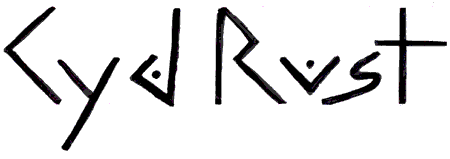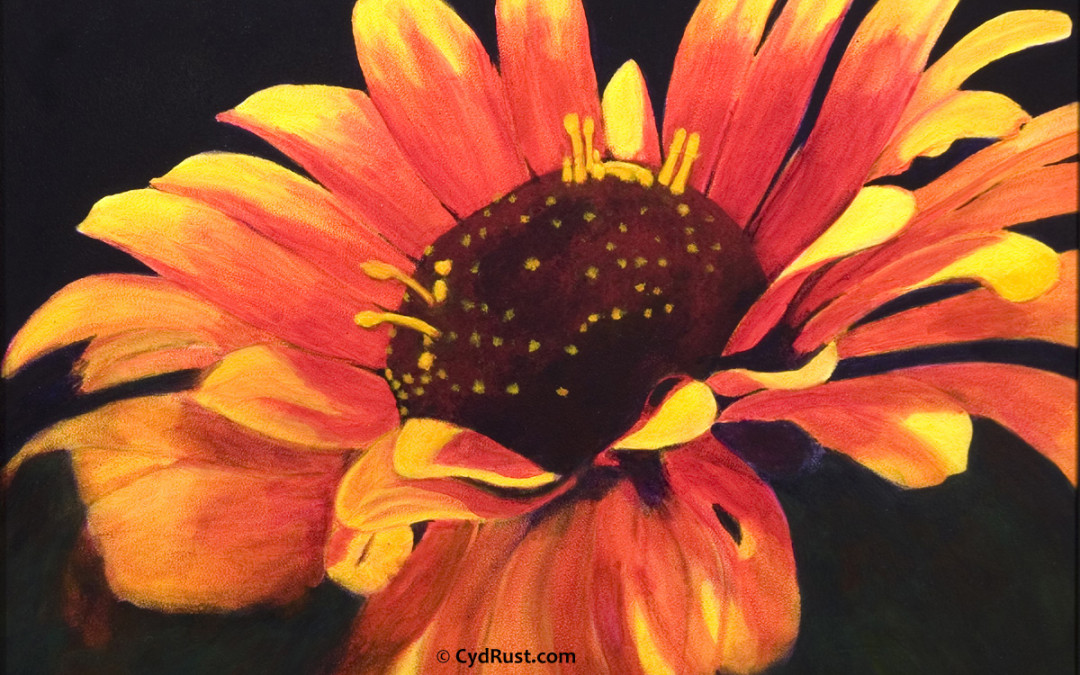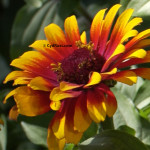I thought it might be fun to do a step by step demonstration of one of my works as I was painting it. This is to be an entry for an upcoming show if it turns out. It is a from a photo of a hybrid Zinnia I shot at the Colorado State University Floral Testing Site.
The flower was very appropriately named a Zowie Zinnia!
Choosing A Substrate
I decided to try an Ampersand Aquaboard for my substrate this time. I was unable to find a smooth board this large locally, which would have been preferred for this painting, so I was forced to use a textured surface. It is my first time using Ampersand’s Aquaboard and I am amazed at how easily even Acrylic can be lifted off this. I will definitely be trying a landscape on this next as I like the texture and effects very much.
Step 1: The Initial Washes
I applied my first two coats of Stephen Quiller Acrylics…using Cad Yellow. Did a very light wash of Cad Orange for shading, and created a light neutral gray with the yellow and Stephen’s own Quiller Violet to overlay the vibrant white of the board’s background. I took the same color darker for the flower center and stem. This entire step is more to give me a blueprint as it were, of where I want to be going, and a guidance of color with an underlayment of hues.
Step 2: The Intermediary Washes
This second round of washes used the same colors on the flowers as before, but I upped the heat a little with Quin Red. That and the mixes I created from the group were then used to begin creating petal definition.
Step 3: The Final Washes Before Beginning Details
This Round I added my first wash of Magenta. I will come back in later and brighten it up even more when I do the detail work. Again, more time spent defining of the flower petals and shadows.
Step 4: Beginning The Background
Before I begin the final detail work, I wanted to begin placing my background to get an overall feel for the painting. All colors in the background are values created using the flower petals and their complimentaries, with the intention of creating varying degrees of neutrals to amplify the already vibrant painting. I am quite pleased at how it is looking.
Step 5: Softening and Defining
In this image I have spent a little more time delineating petals, adding shadows, correcting petal shapes, and beginning to soften edges and play with the background colors a little more. I am still keeping to the limited color palette I started with.
Step 6: Clean up
This was basically the final step before adding the Stamens. I took out a few unnecessary small petals. Reshaped a few to look nicer. Darkened my background as the vibrant colors just weren’t popping as much as I had wanted with the softer background. While I did hate sacrificing that, it just wasn’t allowing the glow I was looking for. I also added the final bit of Magenta and Quiller Violet to the petals.
All that is left is a final coat on the background to even it up where there are thin areas that soaked into the Ampersand Aquaboard, add the stamens, and sign it. :)
I Would Enjoy Hearing Your Comments On This Post.
Thank You For Visiting.
Cyd
Copyright – Cyd Rust-Rust Studios – All Rights Reserved








Good job on the demo Cyd…and on the painting.
Hi Cyd, cool demo. Love the vibrancy of the colours, and the bg really gives it punch. Well done on this…
You are feelin’ this! I can tell! It’s a wonderful demo, too, Cyd. I do hope you put it in your upcoming show! YAY!!!
Helen, thank you. I am glad you like both. :)
Hi Kat. Thank you. Vibrant is one of my favorite words. :)
Hi Beth, I was enjoying this one. I had so much fun playing with these beautiful colors. Glad you like the demo too. And it was put in the show with the varnish barely dry…and got in. yay. :)
Thank you for the props. Cyd